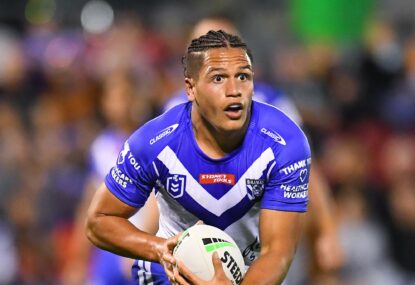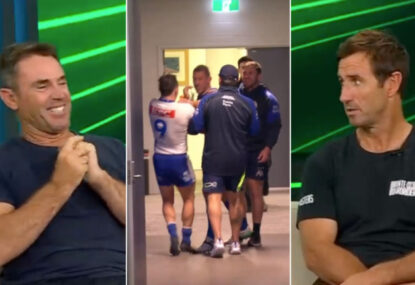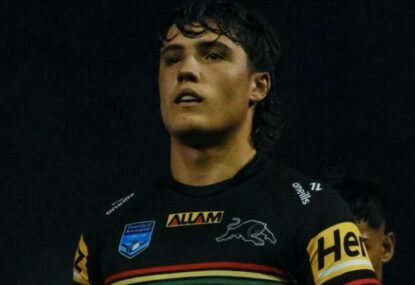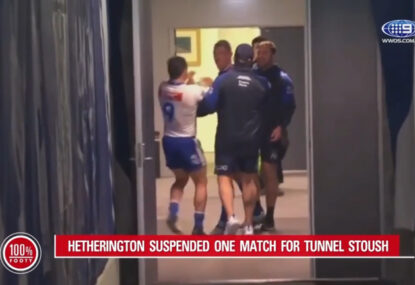With the NRL announcing the controversial Round 13 ‘reversal’ deadline for player contracts is being axed in favour of a ten-day cool-off period, I am advocating the introduction of a transparent, market-value system.
For anyone familiar with the FIFA video game series, when you sign a player you enter the transfer section of the menu and are presented with every single player in world football’s ‘market value’ column and ‘weekly wage’ column.
If you’re Gillingham, you’re probably not going to have the funding to purchase Lionel Messi or Cristiano Ronaldo – but at least you know the price, and can then build a competitive team with the appropriate budget.
By and large, the salary cap has worked and the competition has evened out. But the fact we consistently hear fans and commentators alike proclaiming how Melbourne/Souths/Roosters are premiership favourites, or that for several years now the Cowboys have had the best roster in the competition, or that teams complain about playing a certain club twice in the one season, suggests there is still an underlining issue with the salary cap.
Perhaps the most obvious issue surrounding a clearly defined and visible cap is that other than the overall total, no one has any idea of the specific monetary values of each player at each club. This is a serious issue that threatens the integrity of the game.
Here’s how my system would work. In each season’s pre-season and off-season (this could even be substituted for a Round 13 reevaluation) three separate groups (potentially four if NRL or Big League wants to conduct a fan survey to help weigh into the discussion) place a monetary value on each of the top 25 players in each squad, and five likely rookie debutants for that season or season to come (these debutants would be nominated by the coach of each respective club – think Shane Flanagan nominating Jack Bird before the beginning of this season).
The three groups essentially boil down to: coaches pricing their own players, coaches pricing the rest of the competition’s players, and handpicked ‘elite men and women of league’ (members from the RLPA, NRL governing body, respected commentators and columnists such as Peter Sterling) pricing the competition’s players.
Ultimately these three sectors provide an aggregate player value that dictates a player’s worth.
Once this has been completed, the player values become publicised so that coaches, staff, agents (more on why they don’t get a say in player prices later) and fans alike can see exactly where teams are spending their money.
Now there are two ways to go about the final allocation of price, the more precise (but admittedly more difficult to police) is to have the exact monetary value of the player, or a more basic approach that places the player into a price range – this can be decided in lots of $50,000 per season increments (or whatever increments the NRL may wish).
I would be advocating the more basic approach.
Under this system not only would a club be capped on their salary but to an extent so too would players. This would be achieved by an incremental player value (wage) system.
An incremental player value system would place players in certain categories – the upper echelon of players for example could be called category 1 players. These are the top players in the competition, and the market value after voting would of course reflect that.
Furthermore the earning potential of all players would not actually be that greatly affected. Third-party payments would still be allowed, but they would be regulated.
I’m going to use the Bulldogs as my key example, as most of the Dogs’ forward pack are established stars.
James Graham is the best prop in the world and was purchased as a marquee player. Tony Williams was purchased from Manly on massive dollars. Frank Pritchard was a major signing from Penrith and is a Test forward. David Klemmer and Josh Jackson both recently re-signed and are now Australian international/Origin players.
Sam Kasiano re-signed in 2012 when he was a driving force behind the Bulldogs’ rise and a Test player. Antonio Kafusi I will admit is probably a cheapie, but he has previously played for Australia and Queensland.
Greg Eastwood is a long-time New Zealand rep. Michael Lichaa was purchased on a decent sum, reportedly not too dissimilar from the wage Michael Ennis was earning.
That forward pack alone – which doesn’t include Tim Browne and others – would have to be valued at over $3.5 million. When you consider backs are generally more expensive (especially halves) and there are still the Morris twins, Trent Hodkinson and Josh Reynolds to come, there is no way this team is under the cap utilising salary cap money alone. This method has to accommodate 25 players, and the new minimum wage is $80,000.
The Dogs, as with likely all clubs, are currently under the $6.55 million cap purely because of strategic, third-party payments.
Now the Bulldogs aren’t doing anything wrong, the problem itself lies in the salary cap’s flaws.
Under my market value system coaches would craft the team from the market values alone – irrespective of third-party payments. Given that the price of players would be regulated, they would also be fair.
This also allows the players to then earn whatever external money they could wish from third party revenue, without affecting the club’s salary cap or the league’s integrity. The players are brands these days anyway. Ultimately it’s a winning situation all round.
Teams can’t offer players far cheaper salary cap contracts only to then organise huge sponsorship deals. Minimum contract offers could only drop down say one incremental category.
For example, if Sonny Bill Williams were still playing he would classify as a category 1 player. For arguments sake let’s say this covers players whose market value is determined to be $850,000 and upwards. Category 2 players would for example earn between $849,999-750,000 a season and category 3 would command $749,999-600,000 a season.
SBW would have to be offered a contract in the price range of at least category 2 – irrespective of third-party payments, he could not be offered a contract in categories 3 and beyond.
This puts an onus on all clubs to manage their finances well – and given that the entire process is publicised, including the players’ value, we see exactly how every team spends their cap – which for Tigers fans, for example, means the constant bashing of Chris Lawrence might actually cease!
A transparent market value system would stop the constant debate about teams cheating the cap, would help the competition to become more even, player and club loyalty would potentially be boosted given that player pricing will now be regulated by form, and contribution not simply an agent trying to hike a price to get a higher cut of the sale (that is why agents will not be consulted – of course they can attempt to persuade coaches and pundits and spin some PR to better their cause).
As the game grows, particularly from a corporate point of view, the opportunities for third-party payments are going to increase, and there is no hiding the fact that some teams have a clear and unfair advantage in negotiating such practices.
This system negates those impacts at a team level while still allowing the players themselves to reap the benefits of their own brand.



































































































